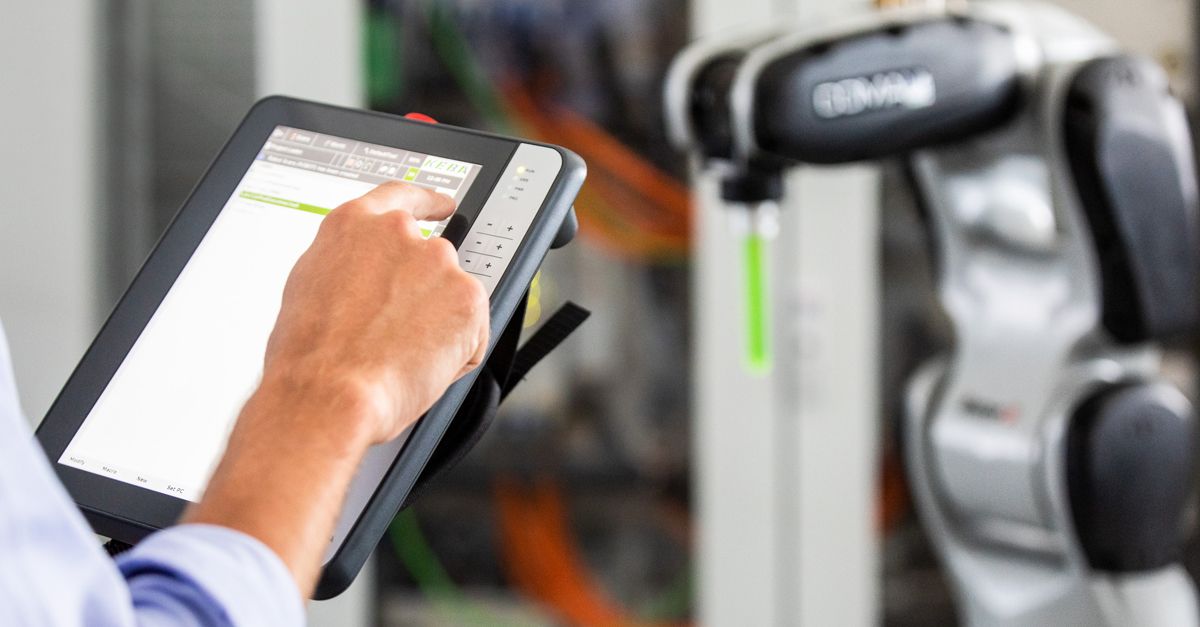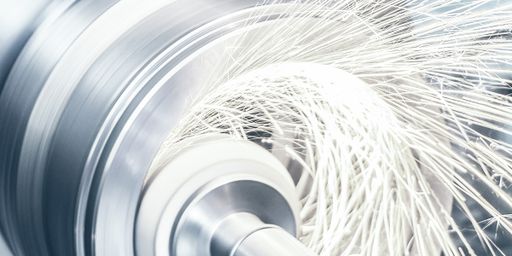Defective mobile hand-held operation devices: HMI repairs FAQs
- HMI
- Service
- 13.9.2022
- Reading Time: {{readingTime}} min
- Share Article

Contents
Machines or robots will more or less take over manufacturing. However, they do need to be operated—using hand-held operation devices. These have evolved into modern high-tech systems that need to meet a wide range of requirements and work with utmost reliability.
However, it is in the nature of things that even hand-held operation devices with multitouch screens and sophisticated software can become damaged or defective with time.
Because our customers frequently contact us with questions concerning repairs of hand-held operation devices, we have compiled this list of answers to questions about repairing KeTop devices.
Why is my hand-held operation device no longer working?
The technology level of your hand-held operation device is comparable to a smartphone or tablet.
The industrial sector prefers hand-held operation devices for good reason: for example, the work environment may be very hard on the device, and ordinary consumer devices are not designed to withstand such harsh conditions.
For this reason, hand-held operation devices are typically designed to be very durable. But over time, damage can still happen, for example to the display screen or the housing. This damage may impair the functionality of the device or even make it necessary to repair or replace the device.
In addition to damaged screens, touch panels or housing, the following defects occur most frequently:
- Damage to emergency-off switches or key-operated switches after the device was dropped,
- cables are cut or broken,
- electrical damage or system damage: the device no longer boots up due to a short-circuit or a defective CPU or PCB,
- software defects or bugs in rare cases.
TIP: Carefully read the manuals of the hand-held operation devices and, if necessary, contact KEBA Support. Because frequently, if hand-held operation devices don’t work as expected, the underlying cause is improper operation or a configuration that is not appropriate for the relevant manufacturing equipment.
Can’t I do my own repairs on my hand-held operation device?
The short answer: maybe. If it happens that your hand-held operation device does not work as expected, a self-check is advisable in most cases in order to figure out whether the device even needs to be returned for repairs. In particular, if the issues occurred right away when the device was put into service.
In this case, it is advisable to look over the hand-held operation device for obvious damage and perhaps to simply reboot the device—you have probably done the same for your PC or smartphone.
Afterwards, it may not even be necessary any more to return your KeTop hand-held operation device to KEBA for repairs. Especially the KeTop remote control units are very easy to check for defects and faults by referring to the QuickStart Guides.
This way, customers are frequently able to get to the bottom of certain defects themselves and can take the appropriate steps. This includes in particular:
- Black screen: this can often be solved with a simple image restore; the KEBA Service team will be happy to assist you with this.
- Check the cables for bent or flattened pins or mating connectors.
- Check the PCB for missing components or damage.
- Check whether the buttons still provide haptic feedback.
- Check the software: for Win10 devices, it may help to reinstall the device or use an image provided by the KEBA Service team.
Did you know: KEBA also offers convenient remote maintenance, which can solve the problem in most cases and eliminates the need for the time-consuming returning of devices for repairs. Our support team will be happy to provide the QuickStart Guides as well as assistance with any repair issues; they can be reached at [email protected].
When is it necessary to return a defective hand-held device for repairs?
A device is defective and needs to be repaired. Such a simple statement, and yet in real life, this is often a cumbersome and time-consuming process. And there are so many questions: How do I need to pack the device? Where do I actually need to send it? What do I need to include in the package? …
The good news: as mentioned above, it is not always necessary return the hand-held operation device if a problem occurs. If the checks recommended here don’t produce a solution, contact the relevant manufacturer or KEBA Support.
The KEBA Service team also offers the option of using TeamViewer to help restore the functionality of your hand-held operating device. If this still does not solve the issue and if it is not possible to return the KeTop hand-held operation device for repairs, then the KEBA Service technicians will also come to you in order to inspect the device on-site and repair it right away, if possible.
KEBA hand-held operation devices are designed and built for the longest-possible service life
Is a replacement device available for the duration of the repair?
In particularly urgent cases, such as when the failure of the hand-held operation device means that the machine is down completely, KEBA offers the option of an advance device replacement, subject to availability. This requires a case-by-case evaluation by the KEBA Repair Center. A general pool of replacement devices does not exist.
Tip: Use the KEBA express repair service at an extra charge of only 250 euros. In most cases, this is the quickest and thus also the most cost-effective option when repairs are unavoidable. An express repair job always requires advance notification.
How long does it take to repair a hand-held operation device?
The time needed for repairing the hand-held operation device depends on several factors. KEBA’s standard turnaround time for repairs of KeTop hand-held operation devices is typically about 10 business days.
However, if your device or individual components need to be sent to third-party services for repair, this process will naturally take a little longer. An exact time cannot be provided until a thorough fault analysis has been performed. On top of that, the time needed for the repair also always depends on the availability of individual spare parts.
As mentioned above, KEBA also offers an express repair service for its KeTop hand-held operation devices. With this service, KEBA will send you a cost estimate within 24 hours upon receipt of the defective KeTop device. The repaired device will be returned to you after only 48 hours.
Keep in mind, though, that this service can only be offered if all spare parts and other materials needed for the repair are actually immediately available—this is not always guaranteed in times such as these.
If delivery bottlenecks affect your repair order, the KEBA Service team will, of course, notify you immediately and update you with the latest status of your KeTop hand-held operation device.
Is it worth repairing my defective hand-held operation device?
All of our hand-held operation devices are designed and built for the longest-possible service life. This means that in many cases, repairs will be worthwhile. From a business perspective, a new purchase is certainly always advisable if the cost for repairing the device is almost as high as the cost for purchasing a new device.
KEBA will provide you with a clear and transparent cost estimate listing all materials, components and labor required to repair your KeTop hand-held operation device.
This will give you a clear idea of the cost for repairing the hand-held operation device so that you can decide what is the most sensible approach from your perspective. When necessary, KEBA will also take care of scrapping any hand-held operation devices that are beyond repair.
Did you know: Safety relevant components such as the emergency stop button are routinely replaced by KEBA in the course of almost all repair jobs because no old components will be re-used on principle.
How long is the warranty for my hand-held operation device?
All KeTop hand-held operation devices pass through a defined product life cycle. The length of this cycle varies by model and product type.
The individual cycles:
- Series stage
- Spare-parts stage
- Repair stage
The first cycle, the series stage, is followed by the spare-parts stage. The final period is the repair stage, during which KEBA is obligated to repair all products. Legacy devices—devices that have passed through the repair stage—will no longer be repaired. It would require too much effort, plus the required spare parts would most likely no longer be available.
The standard warranty for your KeTop hand-held operation devices is twelve months, but this term can be extended by a separate agreement.
Where can I have my defective hand-held operation device repaired?
You have a KeTop hand-held operation device that doesn’t work as it should even after you’ve tried the tips described in this article? Send it to us!
It’s this easy:
Complete the registration form or call us at +43 732 7090 23222. You can also e-mail us: [email protected]
Pack the damaged KeTop hand-held operation device in a secure and well-protected package and mail it to:
KEBA Industrial Automation GmbH
Repair Center BG4
Gewerbepark Urfahr 30
4040 Linz, Austria
Our Repair Center will provide you with a cost estimate.
You decide whether you wish to go ahead with the repair or not.
Your repaired KeTop device will be sent back to you.


























